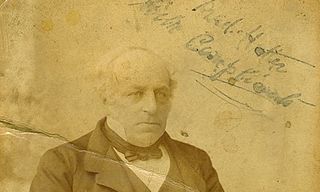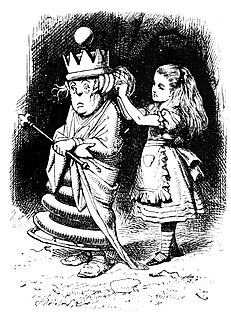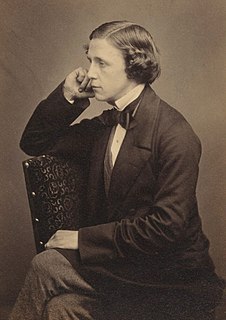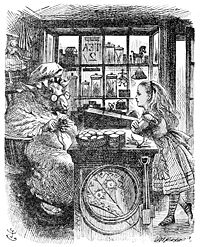
Haddocks' Eyes is a song sung by The White Knight from Lewis Carroll's 1871 novel Through the Looking-Glass, chapter VIII.

"Jabberwocky" is a nonsense poem written by Lewis Carroll about the killing of a creature named "the Jabberwock". It was included in his 1871 novel Through the Looking-Glass, and What Alice Found There, the sequel to Alice's Adventures in Wonderland (1865). The book tells of Alice's adventures within the back-to-front world of Looking-Glass Land.

Through the Looking-Glass, and What Alice Found There (1871) is a novel by Lewis Carroll and the sequel to Alice's Adventures in Wonderland (1865). Alice again enters a fantastical world, this time by climbing through a mirror into the world that she can see beyond it. There she finds that, just like a reflection, everything is reversed, including logic.

Alice's Adventures in Wonderland is an 1865 novel written by English author Charles Lutwidge Dodgson under the pseudonym Lewis Carroll. It tells of a young girl named Alice falling through a rabbit hole into a fantasy world populated by peculiar, anthropomorphic creatures. The tale plays with logic, giving the story lasting popularity with adults as well as with children. It is considered to be one of the best examples of the literary nonsense genre.

Alice in Wonderland is a 1933 American pre-Code film adaptation of the famous Alice novels by Lewis Carroll. The film was produced by Paramount Pictures, featuring an all-star cast. It is all live-action, except for the Walrus and The Carpenter sequence, which was animated by Harman-Ising Studio.

Alice Pleasance Hargreaves, was, in her childhood, an acquaintance and photography subject of Lewis Carroll. One of the stories he told her during a boating trip became the children's classic 1865 novel Alice's Adventures in Wonderland. She shared her name with "Alice", the heroine of the story, but scholars disagree about the extent to which the character was based upon her.

"Vorpal sword" and "vorpal blade" are phrases in Lewis Carroll's nonsense poem "Jabberwocky", which have been taken up in several other media. Carroll never provided a definition of what it really meant. The term has been adopted by the roleplaying game Dungeons & Dragons, where "vorpal" blades have the ability to decapitate opponents on lucky strikes.

The Queen of Hearts is a fictional character from the 1865 book Alice's Adventures in Wonderland by Lewis Carroll. She is a foul-tempered monarch whom Carroll himself describes as "a blind fury", and who is quick to give death sentences at the slightest offense. One of her most famous lines is the oft-repeated "Off with his/her head!" / "Off with their heads!"

Alice Through the Needle's Eye: A Third Adventure for Lewis Carroll's Alice is a 1984 novel by Gilbert Adair that pays tribute to the work of Lewis Carroll through a further adventure of the eponymous fictional heroine, told in Carroll's surrealistic style.

An unbirthday is an event that is typically celebrated on any or all of the 364 days in which it is not the person's birthday. It is a neologism coined by Lewis Carroll in his 1871 novel Through the Looking-Glass, giving rise to "The Unbirthday Song" in the 1951 animated feature film Alice in Wonderland.

The Looking Glass Wars is a series of novels by Frank Beddor, heavily inspired by Lewis Carroll's Alice's Adventures in Wonderland and Through the Looking-Glass. The basic premise is that the two books written by Lewis Carroll are a distortion of the 'true story' portrayed in these novels. It features twists and turns on the original story, such as the white rabbit really being Alyss's (Alice's) tutor, Bibwit Harte, and the Mad Hatter is really a very agile, somber bodyguard called Hatter Madigan.

Theophilus Carter was an eccentric British furniture dealer who may have been an inspiration for the illustration by Sir John Tenniel of Lewis Carroll's characters the Mad Hatter in his 1865 novel Alice's Adventures in Wonderland and Hatta in the 1871 sequel Through the Looking-Glass.

Alice's Shop is a shop at 83 St Aldate's, Oxford, England. With 82 St Aldate's next door it is part of a stone-built 15th-century house that was remodelled in the 17th century. It is now a gift shop selling gifts, souvenirs and memorabilia, all based on Alice.

The White Queen is a fictional character who appears in Lewis Carroll's 1871 fantasy novel Through the Looking-Glass.

Through the Looking Glass is a chamber opera by the Australian composer Alan John to a libretto by Andrew Upton, based on Lewis Carroll's book and on the life of Alice Liddell, the girl for whom Carroll wrote the story's prequel, Alice's Adventures in Wonderland.
"All in the golden afternoon" is the preface poem in Lewis Carroll's 1865 book Alice's Adventures in Wonderland. The introductory poem recalls the afternoon that he improvised the story about Alice in Wonderland while on a boat trip from Oxford to Godstow, for the benefit of the three Liddell sisters, Lorina ("Prima"), Alice ("Secunda"), and Edith ("Tertia"). Alice inspired Carroll's main character, Alice.

Charles Lutwidge Dodgson, better known by his pen name Lewis Carroll, was an English writer of world-famous children's fiction, notably Alice's Adventures in Wonderland and its sequel Through the Looking-Glass. He was noted for his facility at word play, logic, and fantasy. The poems Jabberwocky and The Hunting of the Snark are classified in the genre of literary nonsense. He was also a mathematician, photographer, and Anglican deacon.

Evelyn Hatch was an English child friend of the adult Charles Lutwidge Dodgson, better known by his pen name of Lewis Carroll. She was the subject of photographs by Dodgson and is often part of the contemporary discussion about Dodgson's relationship with young female children. She also acted as editor for a book of Dodgson's letters after his death called A Selection From The Letters Of Lewis Carroll To His Child-Friends.
Alice in Wonderland and Through the Looking-Glass is a 2001 stage adaptation of Lewis Carroll's 1865 novel Alice's Adventures in Wonderland, and the 1871 novel Through the Looking-Glass. It was written by Adrian Mitchell.
















